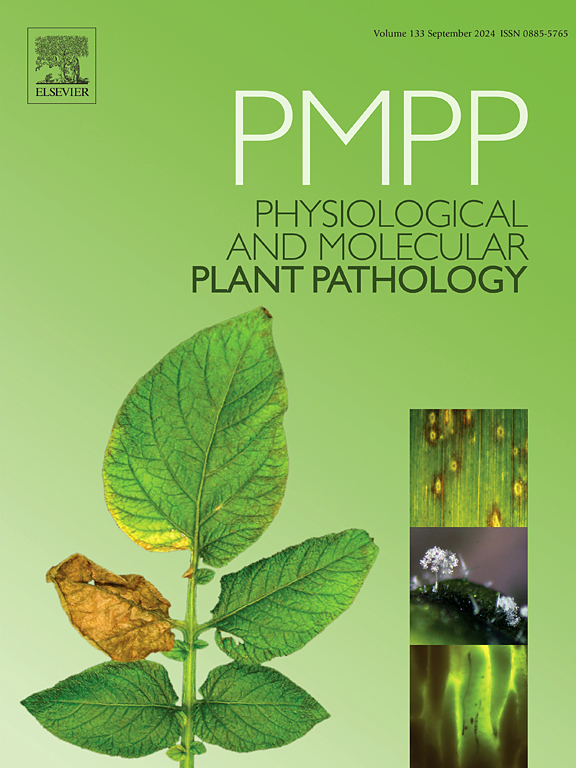Isolation and In Vitro/In vivo evaluation of epiphytic bacterial strains against walnut bacterial blight pathogen Xanthomonas arboricola pv. juglandis
IF 3.3
3区 农林科学
Q2 PLANT SCIENCES
引用次数: 0
Abstract
Bacterial blight of walnut (Juglans regia), caused by Xanthomonas arboricola pv. Juglandis (Xaj) leads to substantial economic losses in walnut-producing regions globally. In this study, epiphytic bacteria isolated from the walnut phyllosphere in Kohgiluyeh and Boyer-Ahmad Province, southwest Iran (2018–2019), were evaluated as potential biocontrol agents against Xaj. Eighty-five epiphytic bacterial isolates from symptomatic and asymptomatic walnut leaves were screened for antagonistic activity against Xaj. Six isolates exhibited inhibitory effects in both ex-planta and in-planta experiments. Among them, D5 and D4 showed the strongest inhibition, with halo diameters of 28 ± 0.06 mm and 27 ± 0.08 mm, respectively, in well diffusion assays. Molecular methods and dendrogram analysis confirmed that D4 was the most similar to Bacillus amyloliquefaciens, and D5 was the most similar to Bacillus subtilis. The other four isolates, K2, H11, B3, and B11, exhibited weaker antagonistic activity compared to D4 and D5 and were identified as Pseudomonas hibiscicola, Pseudomonas putida, Pseudomonas geniculata, and Pantoea agglomerans, respectively. Greenhouse experiments using foliar spray and needle-pricking methods demonstrated that Bacillus amyloliquefaciens and Bacillus subtilis effectively reduced disease severity, necrotic spots on leaves, and the percentage of infected leaf area compared to untreated controls. Importantly, pretreatment with D4 and D5 significantly inhibited the growth of Xaj bacteria in plants. These findings suggest that B. amyloliquefaciens and B. subtilis have potential as biocontrol agents against walnut bacterial blight, providing a more environmentally friendly option than chemical pesticides. The use of phyllosphere-derived Bacillus and Pseudomonas strains represents a sustainable approach that capitalizes on the natural microbiome's inherent advantages over introduced biocontrol organisms. Further research in field conditions is needed to confirm their effectiveness.
核桃枯萎病病原菌树黄单胞菌的分离及体外/体内评价。juglandis
由树黄单胞菌引起的核桃细菌性枯萎病。核桃病(Xaj)在全球核桃产区造成了巨大的经济损失。本研究对伊朗西南部Kohgiluyeh和Boyer-Ahmad省(2018-2019)核桃叶层分离的附生细菌作为潜在的生物防治剂进行了评价。从有症状和无症状的核桃叶片中分离出85株附生细菌,筛选其对Xaj的拮抗活性。6株菌株在植物外和植物内均表现出抑制作用。其中,D5和D4的抑制作用最强,扩散实验中光晕直径分别为28±0.06 mm和27±0.08 mm。分子方法和树突图分析证实D4与解淀粉芽孢杆菌最相似,D5与枯草芽孢杆菌最相似。与D4和D5相比,K2、H11、B3和B11表现出较弱的拮抗活性,分别被鉴定为hibiscicola假单胞菌、putida假单胞菌、geniculata假单胞菌和Pantoea agglomerans。利用叶面喷雾和针刺方法进行的温室试验表明,与未经处理的对照相比,解淀粉芽孢杆菌和枯草芽孢杆菌有效地降低了病害严重程度、叶片坏死斑和感染叶面积百分比。重要的是,D4和D5预处理可以显著抑制植物中Xaj细菌的生长。这些结果表明,解淀粉芽孢杆菌和枯草芽孢杆菌具有作为核桃枯萎病生物防治剂的潜力,提供了比化学农药更环保的选择。利用层球衍生的芽孢杆菌和假单胞菌菌株代表了一种可持续的方法,它利用了天然微生物组相对于引入的生物防治生物的固有优势。需要进一步的野外研究来证实其有效性。
本文章由计算机程序翻译,如有差异,请以英文原文为准。
求助全文
约1分钟内获得全文
求助全文
来源期刊
CiteScore
4.30
自引率
7.40%
发文量
130
审稿时长
38 days
期刊介绍:
Physiological and Molecular Plant Pathology provides an International forum for original research papers, reviews, and commentaries on all aspects of the molecular biology, biochemistry, physiology, histology and cytology, genetics and evolution of plant-microbe interactions.
Papers on all kinds of infective pathogen, including viruses, prokaryotes, fungi, and nematodes, as well as mutualistic organisms such as Rhizobium and mycorrhyzal fungi, are acceptable as long as they have a bearing on the interaction between pathogen and plant.

 求助内容:
求助内容: 应助结果提醒方式:
应助结果提醒方式:


